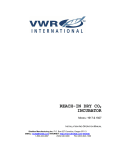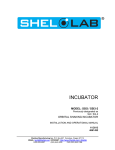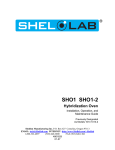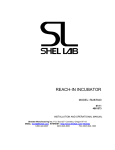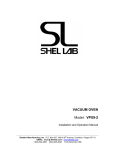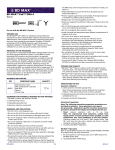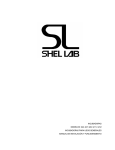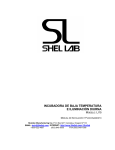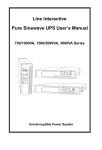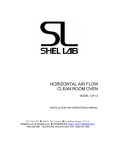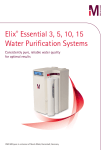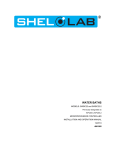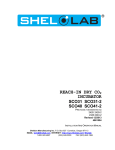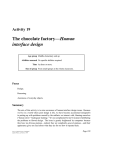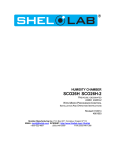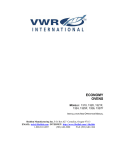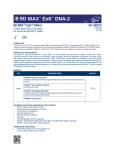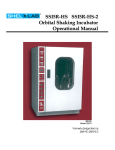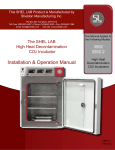Download Hot link to Sheldon Incubator User Manual … pdf
Transcript
LOW TEMPERATURE INCUBATOR MODEL: LI5 INSTALLATION AND OPERATIONAL MANUAL Sheldon Manufacturing Inc. P.O. Box 627 Cornelius, Oregon 97113 EMAIL: [email protected] INTERNET: http://www.Shellab.com/~Shellab 1-800-322-4897 (503) 640-3000 FAX (503) 640-1366 REV. 09/10 4861574 TABLE OF CONTENTS SECTION 1.0 RECEIVING AND INSPECTION SECTION 2.0 INSTALLATION SECTION 3.0 CONTROL OVERVIEW SECTION 4.0 OPERATION SECTION 5.0 MAINTENANCE SECTION 6.0 TROUBLESHOOTING SECTION 7.0 PARTS LIST UNIT SPECIFICATIONS SCHEMATICS This unit is a general purpose Biochemical Oxygen Demand (BOD) incubator for professional, industrial or educational use where the preparation or testing of materials is done at approximately atmospheric pressure and no flammable, volatile or combustible materials are being heated. This unit is not intended for hazardous or household locations or use. 2 Section RECEIVING AND INSPECTION 1 Your satisfaction and safety require a complete understanding of this unit. Read the instructions thoroughly and be sure all operators are given adequate training before attempting to put the unit in service. NOTE: This equipment must be used only for its intended application; any alterations or modifications will void your warranty. 1.1 Inspection: The carrier, when accepting shipment, also accepts responsibility for safe delivery and is liable for loss or damage. On delivery, inspect for visible exterior damage, note and describe on the freight bill any damage found, and enter your claim on the form supplied by the carrier. 1.2 Inspect for concealed loss or damage on the unit itself, both interior and exterior. If necessary, the carrier will arrange for official inspection to substantiate your claim. 1.3 Return Shipment: Save the shipping crate until you are sure all is well. If for any reason you must return the unit, first contact your customer representative for authorization. Supply nameplate data, including model number and serial number. Please see the manual cover for information on where to contact Customer service. 1.4 Accessories: Verify that all of the equipment indicated on the packing slip is included with the unit. Carefully check all packaging before discarding. This unit is equipped with 2 shelves and a humidity pan/ WARNING: Never use this unit for the growth, cultivation, incubation or storage of fruit flies (drosophila melanogaster). This unit is not designed for use with fruit flies. Improper use of this unit, including use with fruit flies, will void any warranty. Other units are specifically manufactured for fruit fly application, and you should consult your dealer or the manufacturer in order to identify another model suitable for your application. 3 Section INSTALLATION 2 Local city, county or other ordinances may govern the use of this equipment. If you have any questions about local requirements, please contact the appropriate local agency. Installation may be performed by the end user. Under normal circumstances this unit is intended for use indoors, at room temperatures between 5 and 40 C, at no greater than 80% Relative Humidity (at 25 C) and with a supply voltage that does not vary by more than 10%. Customer service should be contacted for operating conditions outside of these limits. This unit should remain upright for 24 hours prior to turning on. This will allow the oil settle to in the refrigeration compressor. 2.1 2.2 2.3 2.4 2.5 Power Source: The electrical supply circuit to the incubator must conform to all national and local electrical codes. Consult the incubator’s serial data plate for the voltage, cycle wattage and ampere requirements before making connection. VOLTAGE SHOULD NOT VARY MORE THAN 10% FROM THE SERIAL PLATE RATING. This unit is intended for 50/60 Hz application. A separate circuit is recommended to prevent possible loss of product due to overloading or failure of other equipment on the same circuit. Location: When selecting a site for the incubator, consider all conditions which may affect performance, such as extreme heat from steam radiators, stoves, ovens autoclaves, etc. Avoid direct sun, fast-moving air currents, heating/cooling ducts, and high traffic areas. To ensure air circulation around the unit allow a minimum of 20cm between incubator rear and sides and any walls, partitions or obstructions to free airflow. Lifting / Handling: This unit is heavy and care should be taken to use appropriate lifting devices that are sufficiently rated for these loads. Units should only be lifted from their bottom surfaces. Doors, handles and knobs are not adequate for lifting or stabilization. The unit should be completely restrained from tipping during lifting or transport. All moving parts, such as shelves and trays should be removed and doors need to be positively locked in the closed position during transfer to prevent shifting and damage. Leveling: The unit must sit level and solidly. Turn the leveling feet counterclockwise to raise level. If the unit must be moved, turn the leveling feet in all the way to prevent bending and damage. Cleaning: The incubator interior was cleaned at the factory, but not sterilized. Remove all interior parts and clean with a disinfectant that is appropriate for your application. DO NOT USE abrasives as this will damage the incubators interior. DO NOT USE spray cleaners that might leak through opening and cracks and get on electrical parts or that may contain solvents that will harm the coatings. A thorough periodic cleaning is strongly recommended. WARNING: Never clean the unit with alcohol or flammable cleaners with the unit connected to the electrical supply. Always disconnect the unit from the electrical service when cleaning and assure all volatile or flammable cleaners are evaporated and dry before reattaching the unit to the power supply. 4 Section CONTROL PANEL OVERVIEW 3 3.1 Power Switch: The main power I/O (on/off) switch controls all power to the unit and must be in the I/ON position before any systems are operational. 3.2 Main Temperature Control: This control is marked SET TEMPERATURE and consists of the digital display and UP/DOWN arrow pads for inputting set point temperatures and calibration. 3.3 Heating Lamp: This pilot lamp is marked TEMPERATURE ACTIVATED and is ON when the unit is heating up to set point and is blinking when controlling temperature at set point. 3.4 Overtemperature Thermostat: This control is marked SET OVERTEMPERATURE and is completely independent of the Main controller. It acts as an override in the event that the Main control fails in the ON position. 3.5 Overtemperature Light: This pilot lamp is marked OVERTEMPERATURE ACTIVATED and is on when the thermostat has been activated. Under normal operating conditions, this pilot light should never be on. 3.6 Circuit Breaker: (Non-CE units) Adjacent to the power cord the circuit breaker is an added measure of protection against power source variations that if tripped, must be reset by pushing in the button once the reason for interruption has been cleared. 3.7 Fuse: (CE units only) Located at the back of the unit within the power inlet, the fuse is an added measure of protection against power source variations that, if blown, must be replaced once the reason for the interruption has been cleared. Note that the unit will not power up unless the fuse is in place. 5 Section OPERATION 4 4.1 Check power supply against unit serial plate. They must match. 4.2 Plug service cord into the grounded electrical outlet. 4.3 Push the power switch to the I/On position, and turn the Overtemperature Thermostat to its maximum position, clockwise using a coin or flat edged tool. 4.4 Set Main Temperature Controller: Enter desired set point temperature. To enter set point mode on the controller, press either the Up or Down arrow pad one time. The digital display will start to blink, going from bright to dim. While blinking, the digital display is showing the set point. To change the set point, use the Up and Down arrow pads. If the arrow pads are not pressed for five (5) seconds, the display will stop blinking and will read the temperature of the unit. Note that the Overtemperature Thermostat should be turned to its maximum position, (clockwise) until the unit has stabilized at desired set point temperature. Allow the incubator at least 24 hours to stabilize. 4.5 Calibration: It is recommended that calibration is done once the unit is installed in its working environment and has been stabile at set point for several hours. Place a certified reference thermometer in the chamber. Be certain the thermometer is not touching any shelving. Allow the temperature to stabilize again until the thermometer reads a constant value for one hour. Compare the digital display with the reference thermometer. If there is an unacceptable difference, put the display into calibration mode by pressing both the Up and Down arrow pads at the same time until the two outside decimal points begin to flash. While the decimal points are flashing the display can be calibrated by pressing the Up or Down arrow pads until the display reads the correct value. Allow the incubator temperature to stabilize again, and recalibrate if necessary. 4.6 Set Overtemperature Thermostat: As mentioned previously, the Overtemperature Thermostat should be initially set to its maximum position, (clockwise), to allow the unit to stabilize. Once the incubator is stabile at the desired set point, turn the Overtemperature Thermostat counterclockwise until the OVERTEMPERATURE ACTIVATED light turns on. Next, turn the Thermostat clockwise just until the light turns off. Then turn the Thermostat clockwise 1/16 of an inch past the point where the light went out. This will set the Overtemperature Thermostat at approximately 1 C above main Temperature set point. 4.7 Accessory Outlet: This unit has been supplied with a 1 amp accessory outlet inside the chamber to provide power for equipment such as magnetic stirrers, rockers, etc. Be certain the apparatus draws 1 amp or less. The power switch on the front panel controls power to the outlet. Note that the apparatus may provide additional heat that could affect the temperature range of this incubator. It is recommended that testing be done with the incubator and any accessory equipment to insure that the desired operating conditions can be met. 6 4.8 Load the chamber with sample bottles. See Figure 2 for bottle placement. Figure 2 7 Section MAINTENANCE 5 Note: Prior to performing maintenance and/or service on this incubator, disconnect the unit from the power supply. 5.1 Cleaning: Cleaning and decontamination are recommended on a regular basis. To prepare the unit for cleaning, disconnect the power cord and remove all interior parts, such as shelves, trays, etc. First clean the chamber with soap and water, rinse and let dry. To decontaminate use a solution that is appropriate for your application. DO NOT USE abrasives as this can damage the chamber interior. DO NOT USE spray cleaners that might leak through openings and cracks and get on electrical parts or that may contain solvents that will harm the coatings. NEVER USE acids, chemical thinner, gasoline, benzine or the like for cleaning the unit. Boiling water and benzine can deform and damage plastic parts. WARNING: Never clean the unit with alcohol or flammable cleaners with the unit connected to the electrical supply. Always disconnect the unit from the electrical service when cleaning and assure all volatile or flammable cleaners are evaporates and dry before reattaching the unit to the power supply. 5.2 Compressor Compartments: Located at the back and bottom of the unit, the compressor compartment can collect dust that will inhibit proper air flow. This compartment should be vacuumed out at least once every six (6) months to ensure maximum efficiency. 5.3 Defrosting: Generally defrosting should not be necessary. If ice build-up occurs it is usually attributed to open containers, loose closures or frequent door openings causing excessive moisture to build up in the chamber. Try to eliminate these as possibilities. To defrost, remove all items from the chamber and let the unit stand with the door open and the POWER OFF. Once frost is gone, empty drip tray, wipe the chamber dry and power up the unit. 5.4 Storage: If the incubator is to be shut down for storage or transport, remove all items, drip tray and shelves and be certain the chamber is dry. Screw in the leveling feet. Review section 2.3, Lifting / Handling for transport instructions. 5.5 There is no maintenance required on electrical components. If the unit fails to operate as specified, please review section 6 Troubleshooting, prior to calling for technical service. 8 Section TROUBLESHOOTING 6 FOR PERSONAL SAFETY, ALWAYS DISCONNECT THE POWER BEFORE SERVICING. In the event the incubator does not operate properly, check the following before calling for service. Always make a visual inspection of the incubator and control console when troubleshooting to find loose or disconnected wires which may be the source of trouble. TEMPERATURE Temperature too high Controller set too high. Display reads "HI" Probe is unplugged, is broken or wire to sensor is broken. Temperature too low 1/ Overtemperature thermostat set too low. 2/ Controller set too low. 3/ Unit not recovered from door opening – wait for display to stop changing. 4/ Unit not recovered from power failure or being turned off – incubators will need 24 hours to warm up and stabilize. Display reads "LO" Sensor is shorted. Unit will not heat up at all 1/ Verify that controller is asking for heat by looking for controller light 2/ Do all controller functions work? 3/ Is the Overtemperature set high enough? Indicated chamber temperature unstable 1/ ±0.1 may be normal 2/ Is fan working? 3/ Is ambient room temperature radically changing – either door opening or room airflow from heaters or air conditioning ? – stabilize ambient conditions 4/ Overtemperature set too low. 5/ Electrical noise – remove nearby sources of RFI including motors, arcing relays or radio transmitters Display and reference thermometer don’t match Calibration error. Can't adjust set points or calibration 1/ Turn entire unit off and on to reset 2/ If repeatedly happens, call Customer Service Calibrated at one temperature, but not at another This can be a normal condition when operating temperature varies widely. For maximum accuracy, calibration should be done as close to the set point temperature. REFRIGERATION Unit will not cool If the compressor is running: 1/ See if condenser is cold but free of ice 9 2/ Be sure that fans are circulating air: in the chamber, and over the compressor 3/ Assure there is ample room around the unit as described in Installation. 4/ Compare ambient specifications to Unit specifications. If compressor isn’t running: 1/ Confirm that compressor cooling fan motor is operable a- Dirty coil or poor circulation b- Coil next to heat source c- Ambient temperature too high Ice build up in chamber 1/ Search for leak in door gasket. 2/ door being opened too often. 3/ open container/loose seal on bottles. Making noise 1/ assure that fan is not miss-aligned. 2/ Steady internal clicking may be broken spring or valve – call Customer Service. MECHANICAL Motor doesn't move If shaft rubs or is frozen, relieve binding and retest Motor makes noise 1/ Make sure that the fan or blower wheel is not contacting its housing. Adjust the motor mounting bracket position to re-center the fan or blower wheel, if necessary. 2/ Check the fan or blower wheel for damage or out of balance condition. Replace the fan or blower wheel if it is damaged or out of balance. 3/ Turn the motor shaft to make sure that it spins freely. If it binds or the bearings make a rubbing or scrapping sound then replace the motor. Door not sealing 1/ Confirm that unit has not been damaged and body is square. 2/ Check to see that door gasket is in place and not damaged. OTHER Unit or wall fuse/circuit breaker is blown 1/ Check wall power source 2/ Compare current draw to specs on data plate 3/ See what other loads are on the wall circuit Unit will not turn on 1/ Check wall power source 2/ Check fuse/circuit breaker on unit or in wall Contamination in chamber 1/ See cleaning procedure in operator’s manual 2/ Develop and follow Standard operating procedure for specific application; include definition of cleaning technique and maintenance schedule 10 Section 7 PARTS LIST Description Circuit Breaker Circulating Fan, chamber Convenience Outlet Cooling Fan, compressor Factory Set OverTemperature Control Heating Element I/O (On/Off) Power Switch Main Temperature Controller OTP and Compressor High Cut Thermostat Pilot Light, Green Pilot Light, Red Power Cord, USA Step Down Transformer 115V 220V 1100505 4880545 6100525 4880564 1100505 4880545 6100526 4880564 1750715 1750715 2350508 44.6 ohms 7850570 1750573 2350508 150.1 ohms 7850570 1750574 1750862 1750813 4650554 4650553 1800516 -- 4650554 4650553 1800537 8350515 11 UNIT SPECIFICATIONS Weight Shipping Net LI5 130 lbs. 108 lbs. Dimensions Exterior WxDxH Interior WxDxH (in.) (in.) LI5 20.75 x 21.25 x 38.75 Capacity 3 cubic feet Temperature Range Uniformity LI5 -10 to +45 C +0.5 C @ 20 C 15 x 11 x 25 12 WIRE DIAGRAM 110V 120VAC 1800516 POWER CORD AND PLUG BLK WHT 1100505 CIRCUIT BREAKER 15A BLK MAIN POWER SWITCH 7850532 USED ON LI5 103351 USED ON 2005 BLK 100020 100020 BLK WHT 200021 LI5 ONLY WHT WHT BLK WHT POWER G BLU IF WHT 4880545 INTERNAL FAN WHT BLK 1750573 HOT 37.0 NEUTRAL PROBE GROUND 200020 SAFETY ACTIVATED LOAD R 200021 BLK ORN RED HEATING ACTIVATED 1750715 155°F/68°C 4 1 BLK HT 2 WHT G WHT 45 BLK HT WHT HT 10000J 9570863 ELEMENT ASSY 2350508 ELEMENT COIL 4 YEL 1 2 YEL WHT THE COMPRESSOR IS PART OF THE BASE UNIT 10000J PRESET TO 35°C WHT YEL CF 210002 COMPRESSOR FAN WHT 6750507 (LI5 ONLY) RED BLK + 12VDC POWER SUPPLY 1750742 (LI5 ONLY) SL LOGO BACKLIGHT 9851072 12/11/08 BLK 13 220V 240VAC X1000779 EURO ON LI5-2 101990 USED ON 2005-2 EMI FILTER 2800502 BLK RED 1100505 CIRCUIT BREAKER 15A 1100505 CIRCUIT BREAKER 15A BLK RED 7850532 USED ON LI5 MAIN POWER SWITCH BLK 103351 USED ON 2005 RED 101483 101483 BLK RED X1000779 EURO OUTLETS USED ON LI5-2 200021 LI5-2 ONLY RED BLK RED POWER G RED BLK 1750573 HOT 37.0 NEUTR AL GROU ND PROBE LOAD SAFETY ACTIVATED BLK RED R 200020 ORN HEATING ACTIVATED RED RED 200021 1750715 155°F/68°C 4 1 G BLK HT 2 4 BLK HT 2 ½ 1750813 1 RED HT ½ 1750813 9570864 ELEMENT ASSY 2350508 ELEMENT COIL 6750507 (LI5 ONLY) RED BLK 12VDC POWER SUPPLY 1750742 (LI5 ONLY) + SL LOGO BACKLIGHT BLK WHT BLK BLK 100055 TRANSFORMER 240/120VAC 750VA BRN BRN THE COMPRESSOR IS PART OF THE BASE UNIT 4 YEL 1 2 10000J PRESET TO 35°C YEL RED RED YEL 9851072 12/11/08 CF 210002 COMPRESSOR FAN BLU IF RED 4880545 INTERNAL FAN 14














